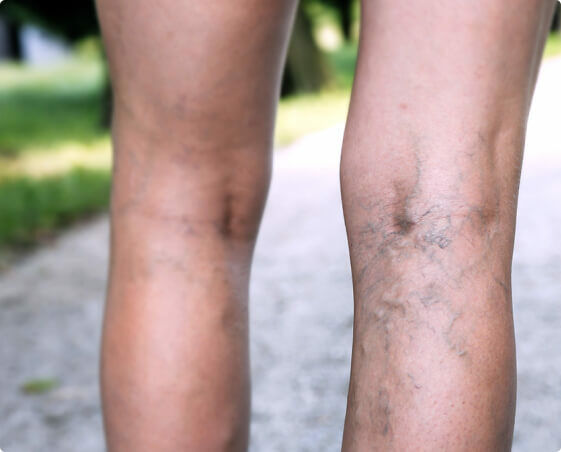
Arteries carry oxygenated blood from the heart to different parts of the body, while veins face the challenge of working against gravity to return blood from the body to the heart. Efficient blood flow back to the heart relies on a few systems: the muscles in the lower legs acting as pumps, the strength of the elastic walls of the veins, and the proper functioning of tiny valves inside the leg veins. These valves open as blood flows toward the heart, allowing it to pass through and then close to prevent backward flow.
When these valves weaken or become damaged, blood can flow in the wrong direction (venous reflux). As a result, blood accumulates and pools in the affected veins, creating pressure and pain and causing veins to stretch, twist, and become visibly swollen and enlarged.
There are many risk factors that contribute to varicose veins. Some factors that increase the likelihood of developing vein disease can be controlled by the individual; others cannot. Often, a combination of these factors results in varicose veins.
By age 50, 41 percent of women will suffer from varicose veins. Similarly, by the time they reach their 60s, 42 percent of men will suffer from venous insufficiency.
Varicose veins are an inherited genetic disorder, with almost 50 percent of varicose vein patients having a family history of the disease. If one parent has vein disease, a daughter has a 60 percent chance of developing varicose veins, whereas a son has a 25 percent chance. Your chances of developing varicose veins are over 90 percent if both parents have the disease.
Female sex hormones tend to weaken vein walls and valves; women are up to three times more likely than men to develop vein disease. The use of oral birth control pills also increases risk.
In addition to powerful hormonal changes that occur during pregnancy, the increased blood volume to support the growing fetus puts added pressure on the veins, particularly in the lower body, where the weight of the uterus compresses the pelvic veins.
Excess weight puts additional pressure on the legs, damaging leg veins by causing them to work harder to pump blood. Blood is more likely to pool as a result. Women with a BMI over 30 are three times more likely to develop varicose veins. Even moderately overweight women have a 50 percent increased risk of developing varicose veins.
A reduction in smooth blood circulation and the effects of gravity can increase pressure in the leg veins. Simple activities like stretching, walking, or flexing the leg muscles can help stimulate blood circulation and relieve this pressure, as can wearing compression stockings.